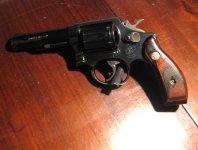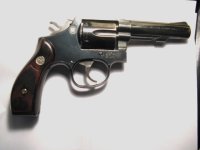Originally posted by SaxonPig
Yes, +P is loaded higher than "standard" ammo, but it is STILL well below the maximum allowable pressure for the caliber. The max was determined to be safe in any 38 revolver of good quality in good condition and +P is BELOW the max.
You and I have circled this tree before methinks. +P ammunition is not loaded below maximum allowable pressure for the cartridge. SAAMI has set 17,000 psi as the maximum average pressure (MAP) for .38 Special and 20,000 psi as the MAP for .38 Special +P. You don't seem to understand that, while .38 Special and .38 Special +P are dimensionally identical, they are in fact two different cartridges loaded to two different pressure specifications not unlike .38 ACP and .38 Super Auto.
http://www.saami.org/specifications_and_information/specifications/Velocity_Pressure_CfPR.pdf
Also, you need to understand that the MAP set by SAAMI is just that: a
maximum. Most manufacturers will load their ammunition a bit below the MAP as a safety margin to compensate for variances in temperature, elevation, bullet setback and other such factors that may be beyond their control. Just because a .38 Spl +P cartridge is not loaded right up to the ragged edge of 20,000 psi does not mean that it isn't still a +P. So long as it is loaded above 17,000 psi but below 20,000 psi it is, by definition, a +P cartridge regardless of whether it's MAP is 17,001 psi or 19,999 psi.
Yes, I've read that article before and a good deal of it is indeed hogwash. You don't seem to be able to understand that the +P designation does not guarantee a certain velocity, it only designates pressure. Pressure and velocity do not directly correlate. Depending on several factors, most notably how fast the particular powder used burns, it is entirely possible to have one cartridge that is loaded to a higher pressure but actually produces a lower velocity than another lower pressure cartridge.
In that article, you continually cite the fact that old ammunition attained higher velocity as proof that modern +P ammunition is fine for old guns. However, you provide no pressure data for that old ammunition so we have no way of knowing if, despite its velocity, it actually produced pressures comparable to today's +P ammo.
Also, you completely ignore the fact that the ammunition of yesteryear was tested on the pressure testing equipment of yesteryear. Personally, I think it's probably fairly likely that the old "hot" ammunition and loading data were probably producing a good deal more pressure than the ammo makers and load data publishers thought they were.
Finally, you cite the fact that you were able to fire several hundred rounds of +P ammo through your M&P and the fact that you haven't heard of many vintage guns blowing up from +P ammo as proof that vintage guns can handle it. The problem herein lies that just because you were able to get away with it in your gun with no apparent ill effect doesn't mean that someone else will be able to do the same. There is a reason why it is considered foolish to start with the maximum load data when handloading: what may be safe in one gun under one set of circumstances may not be from a different gun under different circumstances. As I pointed out before, variations such as temperature, elevation, and bore/chamber dimensions all affect pressure. You have no way of knowing the circumstances under which someone else may try to pull the same stunt after reading your article and posts and they may have a much less favorable outcome than you did.
Also, just because you've not heard about guns blowing up doesn't mean that something is a good idea. I will grant you that a vintage revolver of good quality is unlikely to experience a catastrophic failure from the use of +P ammunition, but that doesn't mean that it won't rapidly go out of time or develop excessive endshake. We also need to remember that the majority of the revolvers we're talking about are 50-60 years old. Because they predate the internet and information age, most of the ones that may have been shot loose probably did so decades ago when reports of such weren't so easily disseminated. Most of the people who own such guns today don't use them as defensive or hunting guns and thus have no need to shoot large quantities of hot ammunition through them as a milder loading will punch a hole in a sheet of paper or soda can just as well.


